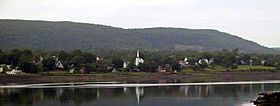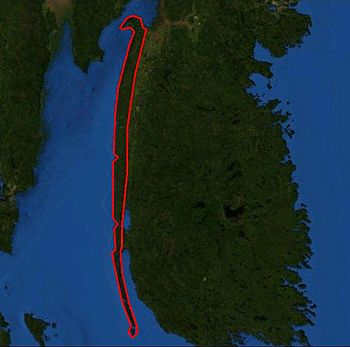North Mountain (Nova Scotia) facts for kids
Quick facts for kids North Mountain |
|
|---|---|

North Mountain ridge above Granville Ferry, Nova Scotia
|
|
| Highest point | |
| Peak | Mount Rose |
| Elevation | 235 m (771 ft) |
| Geography | |
| Country | Canada |
| Provinces | Nova Scotia |
| Geology | |
| Age of rock | Triassic |
| Type of rock | Igneous |
North Mountain (French: Montagne du Nord; Gaelic: Beinn a Tuath) is a long, narrow ridge in Nova Scotia, Canada. It stretches from Brier Island all the way to Cape Split. This ridge forms the northern edge of the beautiful Annapolis Valley. It runs along the shore of the Bay of Fundy.
North Mountain rises steeply from the valley floor. It slopes more gently towards the north and west, where it meets the coast. Many parts of this coast have tall cliffs, some over 30 metres high. The most famous cliffs are at Cape Split.
There is a break in the mountain ridge at Digby Gut. Here, a deep channel filled with ocean water separates the eastern part of the mountain from Digby Neck. The highest point on the ridge is Mount Rose. It is located in Annapolis County, north of Lawrencetown.
How North Mountain Formed
North Mountain is a volcanic ridge. It began forming about 201 million years ago. This was during the Triassic period, when the Earth looked very different. At that time, this part of Nova Scotia was in the middle of a huge supercontinent called Pangaea.
The mountain is made of a type of rock called basalt. This rock formed from lava that flowed out of cracks in the Earth. These lava flows created a hard ridge. This hard ridge was strong enough to resist the powerful ice sheets that covered the area during past ice ages. That's why it still stands tall today, forming one side of the Annapolis Valley.
The Atlantic Ocean's Role
Scientists believe North Mountain was created when the Atlantic Ocean began to open up. It is part of a massive area of volcanic rock called the Central Atlantic Magmatic Province. This huge area covers parts of North America, Europe, Africa, and South America. It is about 4,000 kilometres wide!
You can see special rock formations called "columnar basalt" at places like Baxters Harbour and Brier Island. These look like tall, many-sided pillars of rock.
-
The Balancing Rock, a columnar basalt fragment of the North Mountain near Digby, Nova Scotia.
-
Basal contact of a lava flow section of Fundy basin




